The Great Grapevine Road Fight, Part V
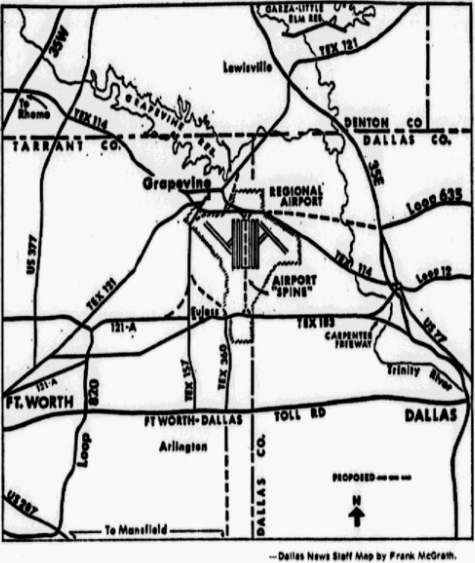
In mid-June 1931 a large motorcade of about 150 cars and 500 people from Riverside visited Grapevine to celebrate the East Belknap project. This project was seen as very important to Riverside and all of Northeast Tarrant County because it would give easy access to Fort Worth through Riverside from Grapevine, Lewisville, Irving, Smithfield and places farther northeast. The Grapevine Sun urged as many citizens as possible to greet the group and attend its 1½-hour entertainment program.
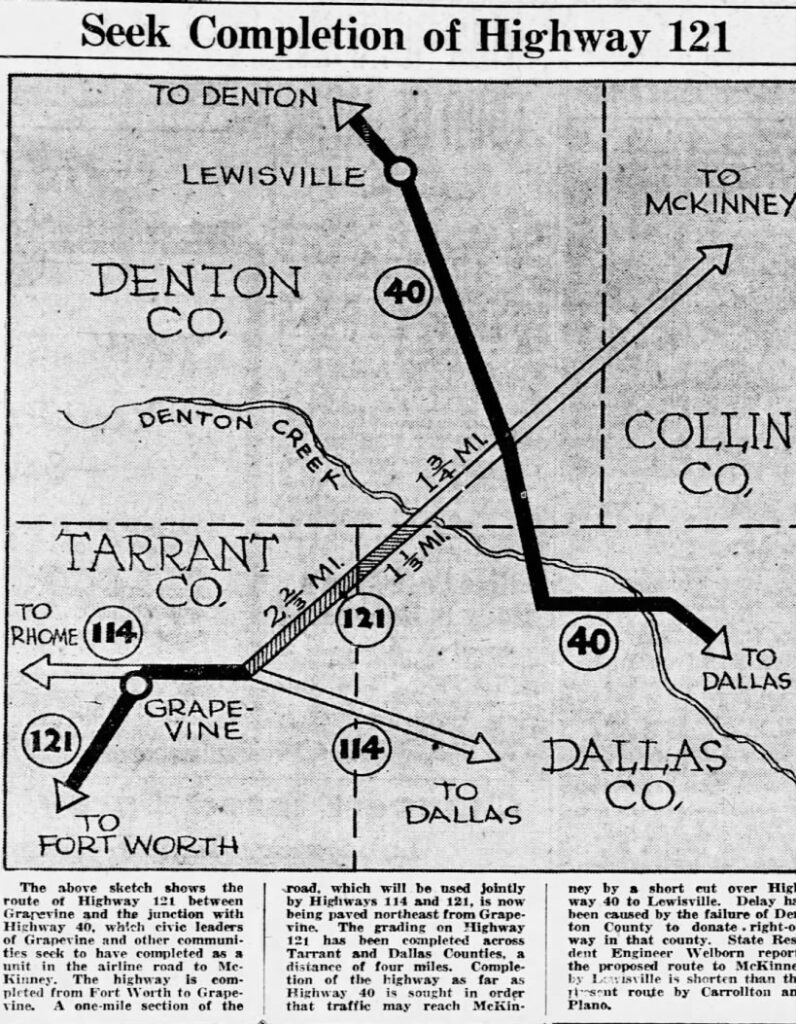
Denton Creek is mistakenly shown completely bypassing northeastern
Tarrant County.
This, however, was not the end of the Great Grapevine Road Fight. Grading of four miles of State Highway No. 121 had been completed across Tarrant and Dallas Counties to the Denton County line by December 1931, and concrete paving began in early June 1932. But roadwork stopped at the Denton County line because six Denton County property owners holding twenty-four acres had not given right-of-way for the 1½-mile stretch through there to the Collin County line (Figure 1). County officials and members of the Chamber of Commerce highway committee met with the Denton County Commissioners’ Court in September 1933. Putting that road through Denton County would cost $3,500, and would shorten the current distance between Grapevine and McKinney by four miles. It would also connect Highway No. 121 with Highway 40 which ran from Dallas through Lewisville to Denton.
In January 1934, after getting nowhere with the Highway No. 121 right-of-way problem in Denton County, the Fort Worth Chamber of Commerce considered routing the road through Dallas and Rockwall Counties with Dallas County’s financial aid. It would cross Federal Highway 75 (running from Dallas into Oklahoma via Sherman and Denison) south of Plano and be only a few miles longer than the previous route. It seemed that the Great Grapevine Road Fight was over, but in mid-July, Precinct 3 commissioner Frank T. Estill announced that the program might be revived under the state’s new policy of buying roadways. On August 20, 1935 citizens and officials of Tarrant, Denton, and Collin Counties met to discuss the issue.

Road Dreams Realized
Former Precinct 3 commissioner Sandy Wall died at age 63 on April 23, 1934. His legacy – the concrete laid from Sylvania Avenue in Riverside to the Grapevine Road with Precinct 3 funds he had saved, and the completion of a permanent all-weather road to Grapevine that became a state highway – was remembered on July 30 in a ceremony in his memory at the recently completed Twenty-eighth Street Viaduct in Fort Worth. It included a military salute, a two-hour fireworks display, and a speech by Harry Hines, chair of the State Highway Commission. Commissioner Wall also initiated the movement for State Highway 15, for which the new viaduct had been developed. He arrived in Texas at a time when cattle trails were used for roads and had lived to see several of his highway improvement dreams come true.
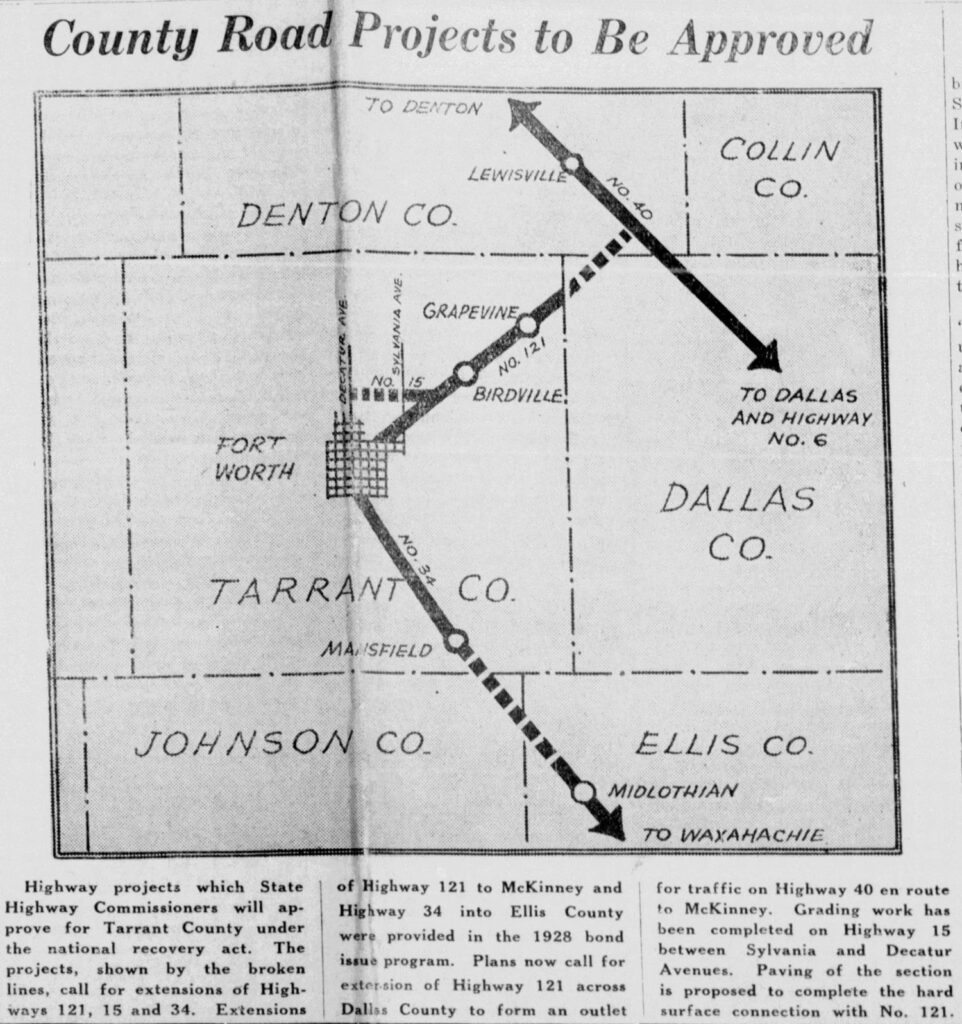
By late September 1937 efforts were once again made to revive the Highway No. 121 extension plan. T. C. Jones, chairman of the Fort Worth Chamber of Commerce Highway Committee, stressed that completion of the highway through McKinney and on to Paris was “the most important project to Fort Worth of any on which we now are working.” In December the Collin County Commissioners Court also requested this action. Precinct 3 commissioner Frank Estill of Grapevine was among the discussion participants.
Also, the one-mile stretch of the road used jointly by Highways 114 and 121 was paved in 1932 and designated part of the Highway System in February 1938.
Because Tarrant County was backing this project, Denton County wanted Tarrant to carry the $2,000 burden of purchasing the required right-of-way. At a parley in March 1938 which Estill and Grapevine banker and Business Men’s Club secretary-treasurer David Box also attended, Denton County claimed that Fort Worth and Tarrant County merchants would be the primary beneficiaries and so should bear that cost. Tarrant County Judge Dave Miller was amenable to paying $1,000 if Denton would secure the right-of-way over the desired 1.10-mile strip of land and donate the remaining $1,000. This was considered the brightest prospects for completion of Highway 121 in the ten years since its inception. Tarrant County raised its portion through subscription. By early May Denton County had obtained the necessary right-of-way.
In early December 1938 most of the dirt grading was done and gravel was being placed on the section that would become Highway 121 in Denton County to Highway 40, including a new concrete bridge over Denton Creek. Work was completed by late December. In early January 1939, the State Highway Commission ordered that Highway 121 be described “[f]rom a junction with U. S. Highway No. 77 near the Denton-Dallas County line via Grapevine to Fort Worth.”
Officials from McKinney as well as Denton and Tarrant Counties appeared before the State Highway Commission in early October 1940 to make their case for the highway extension. Plans were given to state engineers for study. It was not until December 1943 that the commission would order Highway 121 be further extended to McKinney from its current end at Highway 77, ultimately leading to Bonham.
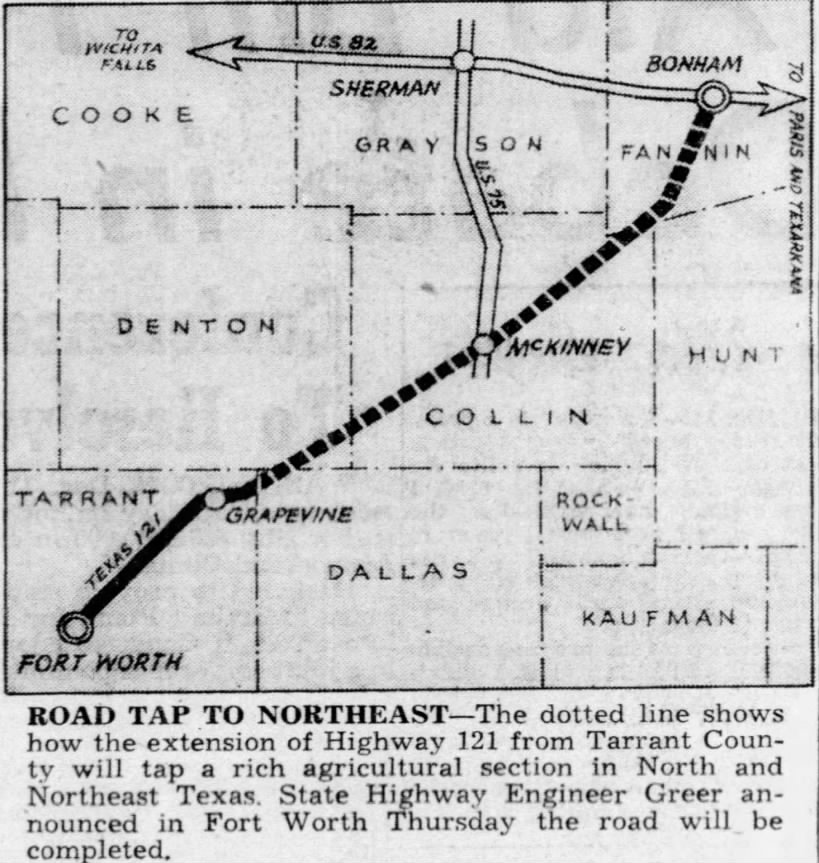
The reality of the McKinney extension, however, did not happen until December 1947 when the state highway engineer announced that the road would be completed (Figure 4). A month later the extension of Highway 121 through McKinney was approved, and on February 11, 1948, McKinney voters approved the measure, 934 for to 351 against. In late June 1950, all right-of-way between McKinney and Bonham had been secured. By the end of July 1951, just one last mile of right-of-way was needed to connect Highway 121 to Fort Worth to McKinney via Grapevine. The road was expected to be done in a year but was not completed until around late July or early August 1951. Moreover, the project had taken on added significance with the construction of the Grapevine Reservoir, whose south abutment just about reached the road.
Battle Not Yet Over
Though the goal of Tarrant County commissioner Sandy Wall, the Fort Worth Chamber of Commerce, and other officials had been achieved by the summer of 1951, Grapevine’s road fight was not over.
Northeast of Loop 820 the 1955 freeway master plan for Tarrant County showed the planned State Highway 121 freeway following its original alignment to Grapevine, which today is known as State Highway 26, the Grapevine Highway (Hurst), Colleyville Boulevard (Colleyville), and Ira E. Woods Avenue/26 (Grapevine). (In 1958 the Fort Worth Star-Telegram called the original Fort Worth to Grapevine route “tortuous.”) By 1958 a more southerly route was under consideration to better serve Euless, Bedford and the Greater Southwest International Airport (later Dallas-Fort Worth International). To achieve this task, in February 1958 officials from Grapevine, Hurst, Bedford, Euless Colleyville, and Richland Hills began efforts to obtain Texas Department of Transportation (TxDOT) approval of Highway 121 outside Loop 820, then calling it Highway 121-A. In mid-April 1958 the Tarrant County Commissioners Court approved right-of-way purchase for relocation of Highway 121 from the North-South Freeway (I-35W) to Richland Hills and improvements on Grapevine Highway. The route was designated as a freeway by TxDOT in early August 1962 using the southern alignment. By September 1962 Grapevine officials were looking to have Highway 121 extended into their city.
In March 1964 the Fort Worth Chamber of Commerce invited representatives of forty communities in Tarrant, Parker, Wise Johnson, and Ellis Counties to a dinner to discuss mutually beneficial highway improvement. From this, the Metropolitan Highway Committee was formed, led by chairman Larry H. Meeker. Mayor Ira E. Woods asserted that it was time for Grapevine, Fort Worth, and Tarrant County to join together for their mutual economic benefit in immediately relocating and constructing Highway 121 from Fort Worth to Grapevine into a four-lane expressway. He considered this the top road priority for several reasons, including the rate of growth and its effects on traffic to Lakes Grapevine and Lewisville, as well as the fact that Highways 121, 360, and Farm Road 157 (Grapevine-Arlington Road) were the only roads carrying the traffic. On top of that, Grapevine was the only practical roadway between Tarrant County and areas northeast of Grapevine.
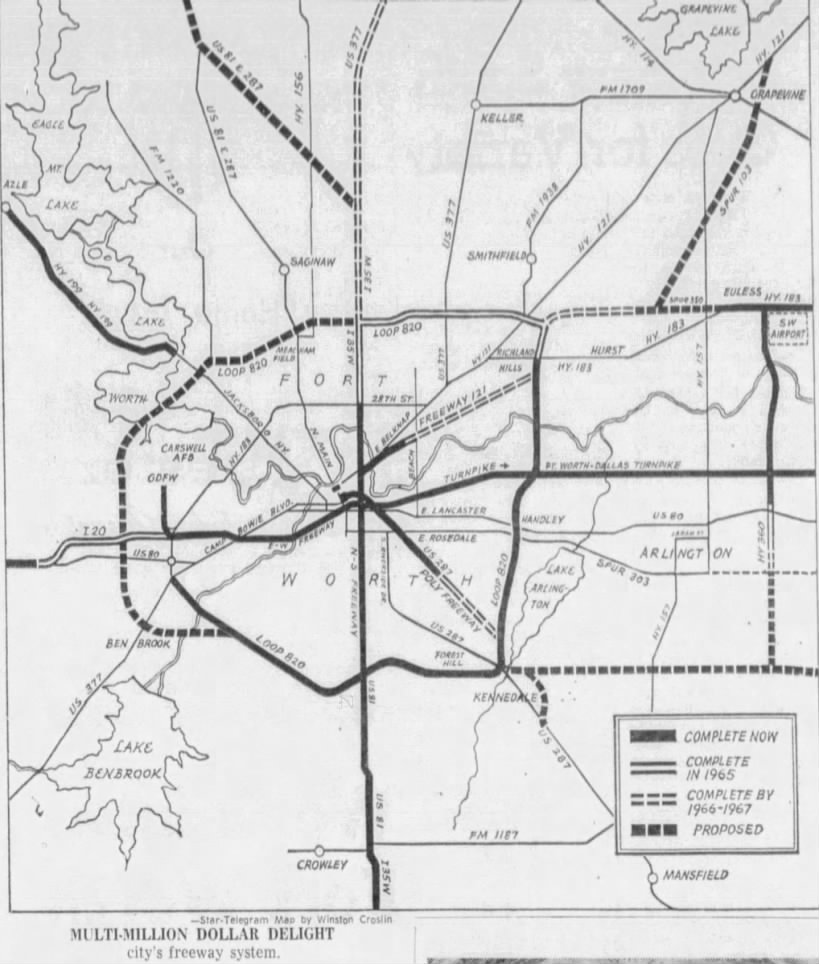
When representatives of the Metropolitan Highway Committee met with officials in Austin at the end of October to make their case for a ten-point highway improvement program for Tarrant County, Dr. Woods and Joe Box of Grapevine were among them. Besides making Highway 121 the top project priority, Chairman Meeker pointed out another significant benefit to the new road – it could be designated as the route to a proposed regional airport serving the Dallas-Fort Worth area if one was built in the Grapevine area. He drove his point home by emphasizing that “Tarrant County simply can not [sic] wait until 1980 or later for this road.” The Highway Commission pledged its full consideration.
This long-range development program allowed for a “triage” of the various programs and made it easier for the Highway Commission to decide which of the projects should take priority. By the end of December 1965, a $3,745,000 contract had been awarded and work had begun on extending the new Freeway 121 from Beach Street to Loop 820. Other contracts were awarded for work from Precinct Line Road to Bedford-Euless Road and from Loop 820 to Precinct Line Road. In mid-April 1966 the Metropolitan Highways Committee reported that the Beach Street to Loop 820 project was seventy-six percent complete; Loop 820 to Precinct Line Road, five percent complete; and Precinct Line to Bedford-Euless Road fifteen percent complete. The Highway Commission had predicted that the new freeway would be completed sometime in 1967, but because the road was being built in stages as funds became available, the commission expected it would be completed by the time the airport opened in 1972 (Figure 5).
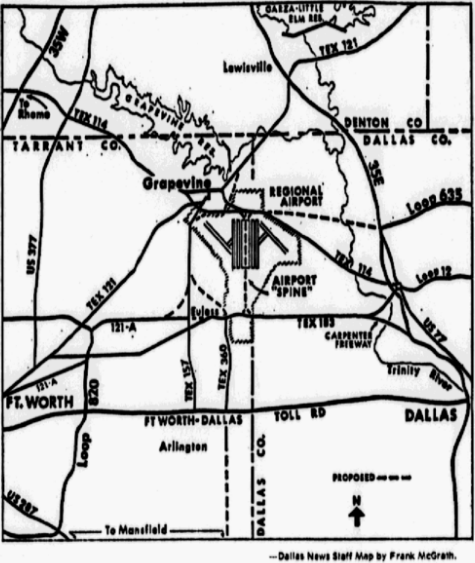
On June 19, 1969, the State Highway Department conducted a hearing attended by over 300 people at the Grapevine High School auditorium. Grapevine was represented by Mayor Willis Pirkle, Floy Ezell, and Jimmy Payton, chair of the city’s Chamber Highway Committee. Grapevine-area projects were discussed that included the proposed route of the final segment of the Fort Worth-Grapevine Freeway. Freeway 121 would angle northeast from the Bedford interchange (Spur 350) and follow the route 2.3 miles to intersect Highway 157 near Little Bear Creek. The new road would parallel 157 for over three miles, one-fourth mile south of Decker-Bradford Road. It would then curve to the right and intersect the interchange at Highway 114 between Grapevine’s Main Street and 157. This would require 400 feet of right of way. The road would also be a segment of the north-south traffic artery through the airport. Nobody at the session objected to anything in this plan. The only request was that there be no delay.
“The Transportation Capital of Texas”
By March 1970, the Fort Worth Star-Telegram declared that Grapevine – “a once sleepy town” – could now call itself “Transportation Capital of Texas” because of its geographic location and future construction of an 18,000-acre regional airport at its doorstep (Figure 6). Additionally, Grapevine officials predicted that the plan for Freeway 121 to follow Highway 157 along the west side of the airport to Grapevine would result in an industrial boom in the area. At the end of June 1970, plans were approved to widen State Highway 121 to four lanes from Colleyville to Grapevine and to modify roads around Grapevine High School.
Construction on the new freeway was almost complete by September 1971. The access roads to the new link were done. Texas 121 and Spur 350 between Brown Trail Drive in Hurst and the intersection of Texas routes 183 and 360 in Euless were graded and paved, but the road would not be ready for traffic until late October due to other ancillary tasks. Construction of the rest of 121 to Grapevine, however, was still more than two years away, as right of way acquisition would take that much time to complete and no funds had yet been allocated. Right-of-way appraisals for the remainder of 121 to Grapevine was to begin by the summer of 1972, half paid by the state and half by Tarrant County. Opening of the airport was set for July 1973, but because of the appraisal time the road would not be ready; however, it was expected to be done before traffic increased to the point that the extension would be needed. The freeway to the south entrance of the airport, consisting of State Highways 121 and 183, was complete by January 1972 (Figures 7 and 8).
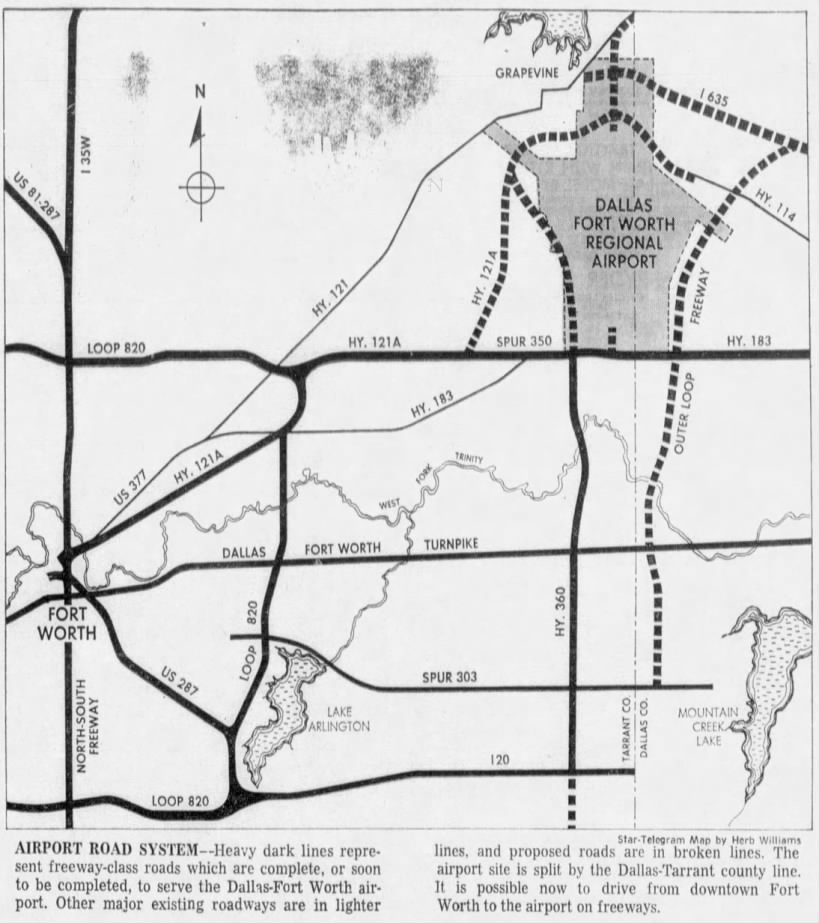
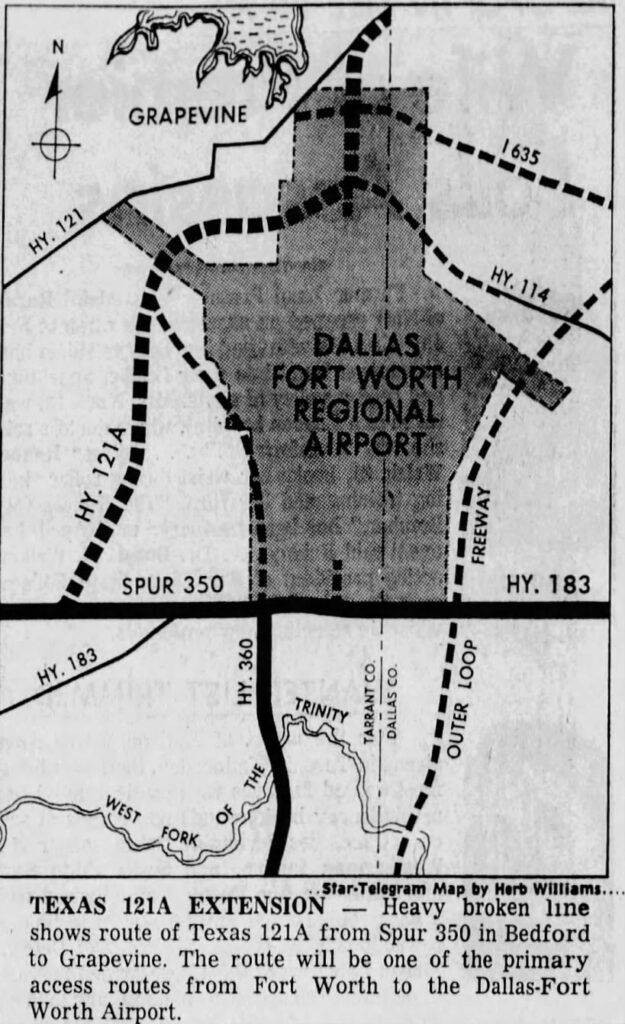
1972, p. 4.

All right-of-way for the four-lane 121 extension was acquired by September 1975. The road would connect with Highway 114 at the north boundary of the airport, with an interchange to be built where South Main Street in Grapevine ended.
On April 14, 1980, the State Highway Commission ordered that the previously mentioned actions to extend Freeway 121 take place. It also ordered that the old Highway 121 running from Grapevine to Interstate 820 be cancelled and re-designated as State Highway 26 (Figure 9). Additionally, it ordered that Farm to Market Road 157 from its junction with the new location of 121 to its junction with 114 be cancelled and re-designated at State Highway 121. Lastly, the portion of 157 in Grapevine from its junction with 114 northward to its junction with the old 121 would be cancelled, removed from the state highway system, and returned to Grapevine for maintenance.
At its meeting on July 1, 1980, the Grapevine City Council considered a resolution naming Highway 26 within the city limits of Grapevine. Among the names discussed were Barton Starr Avenue in memory of the city’s first mayor, and Ira E. Woods Avenue, in memory of Mr. Woods’s contributions
as mayor. It was moved and seconded to name the road Ira E. Woods Avenue. A slight spelling error on the re-titled street signs (Ira A. Woods) caused a little embarrassment for city officials once it was discovered but was then quickly corrected.
Construction on the new Texas 121 from 183 to 114 began in July 1985. A year or so later that stretch was “little more than a red-hued ribbon of unearthed clay” but the work was on schedule. Two contracts were awarded; one was for work from Texas 183 to Big Bear Creek; the other was from Big Bear Creek to Texas 114. In late August 1987 the southbound lanes of 121 were opened to traffic. In early September 1987 the State Department of Highways and Public Transportation District 2 in Fort Worth said that northbound 121 could be ready within a couple of weeks. The old asphalt roads would become service roads. The entire 121 road construction project (including exit roads) between Highways 114 and 183 was scheduled for completion by November 1988. The 1.6-mile expansion of Highway 121 from Highway 360 to north of the airport was begun in August 2016 and was completed in the fall of 2018 as part of the $1.1-billion DFW Connector project.
The Road Long Remembered
In 1930 the Grapevine Business Men’s Club announced that the time had come for city to “[let] the world know where Grapevine is located” and how significant its location was to the economic growth of Fort Worth and Tarrant County. The key to making that happen was the Great Grapevine Road Fight which led to development and improvement of an old dirt road with many twists and turns into a major multi-lane highway to Grapevine and beyond.


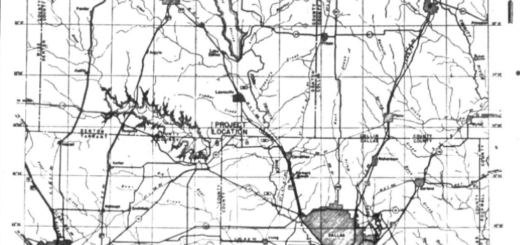
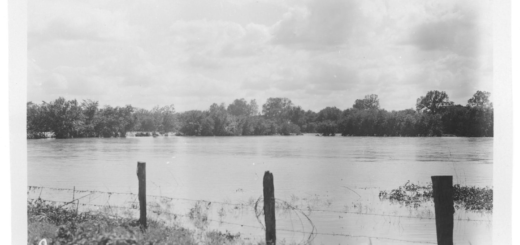
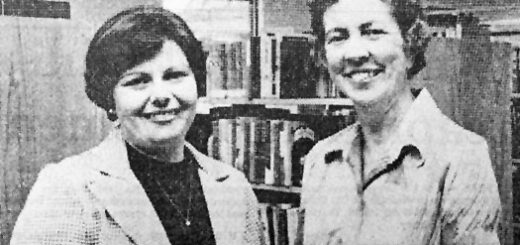
Recent Comments